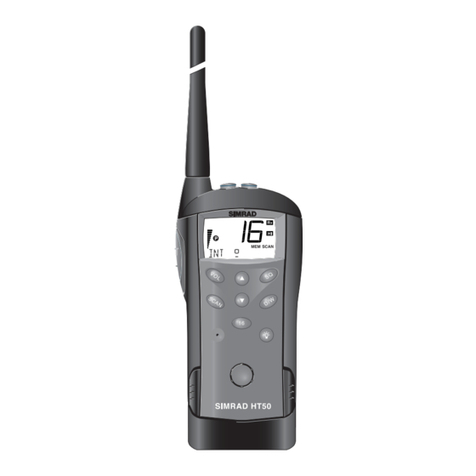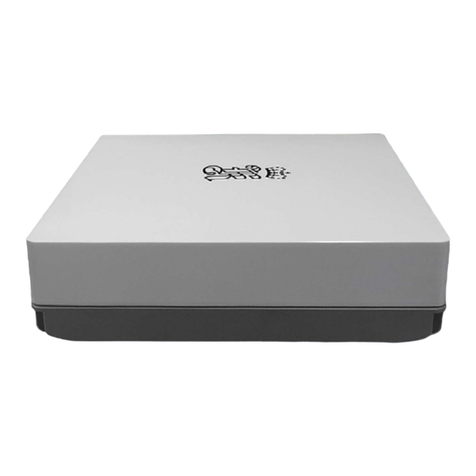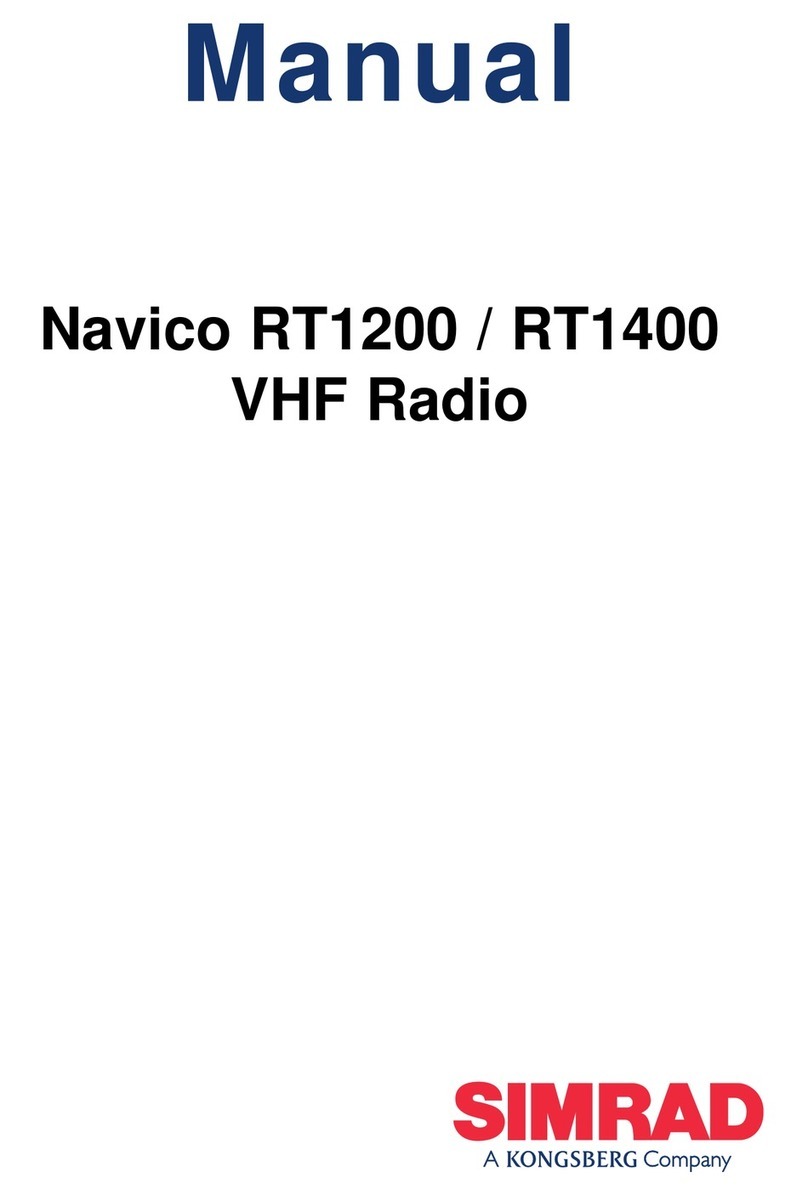Kongsberg Simrad RD68 User manual

Manual
Simrad RD68
Fixed DSC VHF Radio
All manuals and user guides at all-guides.com
all-guides.com

RD68
Part No. E03912 Issue 1.0 28/6/00 MDL
The technical data, information and illustrations contained in this publication were to the best of our knowledge correct at the time of
going to print. We reserve the right to change specifications, equipment, installation and maintenance instructions without notice as part
of our policy of continuous development and improvement.
No part of this publication may be reproduced, stored in a retrieval system or transmitted in any form, electronic or otherwise without
prior permission from Simrad Navico Ltd.
No liability can be accepted for any inaccuracies or omissions in the publication, although every care has been taken to make it as com-
plete and accurate as possible.
© 2000 Simrad Navico Ltd
All manuals and user guides at all-guides.com

Instruction Manual
CONTENTS
1. GENERAL 1.1 Introduction . . . . . . . . . . . . . . . . . . . . . . . . . . . . . . . . . . . . . . . . 4
1.2 Licensing . . . . . . . . . . . . . . . . . . . . . . . . . . . . . . . . . . . . . . . . . . . 5
1.3 Entering MMSI numbers . . . . . . . . . . . . . . . . . . . . . . . . . . . . . . 6
2. MAIN FUNCTIONS
2.1 General . . . . . . . . . . . . . . . . . . . . . . . . . . . . . . . . . . . . . . . . . . . . 8
2.2 Rotary controls . . . . . . . . . . . . . . . . . . . . . . . . . . . . . . . . . . . . . . 8
2.3 Backlighting . . . . . . . . . . . . . . . . . . . . . . . . . . . . . . . . . . . . . . . . 9
2.4 Changing channel . . . . . . . . . . . . . . . . . . . . . . . . . . . . . . . . . . . . 9
2.4.1 Standard International channel . . . . . . . . . . . . . . . . . . . . 9
2.4.2 Auxiliary & Private channels . . . . . . . . . . . . . . . . . . . . . 10
2.5 Transmit power . . . . . . . . . . . . . . . . . . . . . . . . . . . . . . . . . . . . . 11
2.6 Making a DSC call . . . . . . . . . . . . . . . . . . . . . . . . . . . . . . . . . . . 11
2.7 Sending a Distress Alert call . . . . . . . . . . . . . . . . . . . . . . . . . . . 14
2.8 Receiving a DSC call . . . . . . . . . . . . . . . . . . . . . . . . . . . . . . . . . 16
2.9 Dual Watch . . . . . . . . . . . . . . . . . . . . . . . . . . . . . . . . . . . . . . . . . 17
2.10 Tri Watch . . . . . . . . . . . . . . . . . . . . . . . . . . . . . . . . . . . . . . . . . . . 18
2.11 Scan Mode . . . . . . . . . . . . . . . . . . . . . . . . . . . . . . . . . . . . . . . . . . 19
2.11.1 Inhibit / enable channel from scan . . . . . . . . . . . . . . . . . 19
2.12 Memory scan . . . . . . . . . . . . . . . . . . . . . . . . . . . . . . . . . . . . . . . 20
2.12.1 Add / remove memory scan channels . . . . . . . . . . . . . . 21
2.13 Priority channel & user channel select . . . . . . . . . . . . . . . . . . . 22
2.13.1 Programming user channel . . . . . . . . . . . . . . . . . . . . . . . 22
2.14 Viewing call log . . . . . . . . . . . . . . . . . . . . . . . . . . . . . . . . . . . . . 23
3. MISCELLANEOUS FUNCTIONS
3.1 Adjusting LCD contrast . . . . . . . . . . . . . . . . . . . . . . . . . . . . . . . 24
3.2 Entering manual position & time . . . . . . . . . . . . . . . . . . . . . . . 25
3.3 Entering local time . . . . . . . . . . . . . . . . . . . . . . . . . . . . . . . . . . . 27
3.4 Viewing the directory . . . . . . . . . . . . . . . . . . . . . . . . . . . . . . . . . 28
3.4.1 Adding entry to directory . . . . . . . . . . . . . . . . . . . . . . . . 29
3.4.2 Editing / deleting entry . . . . . . . . . . . . . . . . . . . . . . . . . 30
3.5 Disabling key beep . . . . . . . . . . . . . . . . . . . . . . . . . . . . . . . . . . . 32
3.6 Second channel mode . . . . . . . . . . . . . . . . . . . . . . . . . . . . . . . . 33
3.7 Speaker mute (handset models only) . . . . . . . . . . . . . . . . . . . . 33
4. INSTALLATION
4.1 VHF installation . . . . . . . . . . . . . . . . . . . . . . . . . . . . . . . . . . . . . 34
4.2 Antenna installation recommendations . . . . . . . . . . . . . . . . . . 37
4.3 Electrical interference suppression . . . . . . . . . . . . . . . . . . . . . . 39
5. APPENDIX 5.1 Operating procedures . . . . . . . . . . . . . . . . . . . . . . . . . . . . . . . . 40
5.2 Transmission range . . . . . . . . . . . . . . . . . . . . . . . . . . . . . . . . . . 42
5.3 Frequency of channels . . . . . . . . . . . . . . . . . . . . . . . . . . . . . . . . 43
5.4 Fault finding . . . . . . . . . . . . . . . . . . . . . . . . . . . . . . . . . . . . . . . . 44
5.5 Optional accessories . . . . . . . . . . . . . . . . . . . . . . . . . . . . . . . . . . 45
5.6 Technical specification . . . . . . . . . . . . . . . . . . . . . . . . . . . . . . . . 46
5.7 Dimensions . . . . . . . . . . . . . . . . . . . . . . . . . . . . . . . . . . . . . . . . . 47
5.8 Service & warranty . . . . . . . . . . . . . . . . . . . . . . . . . . . . . . . . . . . 48
All manuals and user guides at all-guides.com

1 GENERAL
1.1 Introduction
The RD68 is a combined VHF radio and Class D Digital
Selective Calling (DSC) unit. It supports the latest GMDSS
requirements for non-SOLAS vessels from the International
Maritime Organisation (IMO). It will enable you to make digi-
tally selected calls, which are quicker and simpler to make than
traditional voice calls using Channel 16. Should a distress situ-
ation occur, with the RD68 you can quickly raise an alert, indi-
cating your identity, your position and automatically establish
distress communication on the emergency voice channel.
The RD68 is robustly constructed using a pressure die cast alu-
minium case for effective heat dissipation, ensuring maximum
transmission performance even after many hours constant use.
Thank you for choosing Simrad
If you are pleased with your VHF we hope you will be interest-
ed in our range of marine electronic equipment, which is man-
ufactured to the same high standards as the RD68. Please con-
tact your nearest Simrad Agent for a catalogue showing our
increasing range of high tech navigational instruments, GPS,
autopilots, Radar, Fishfinders and VHF radio sets.
Simrad operate a policy of continual development and reserve
the right to alter and improve the specification of their prod-
ucts without notice.
RD68
4E03912
Fig 1.1 - RD68 Combined VHF & DSC
All manuals and user guides at all-guides.com

1.2 Licensing
NOTE Prior to use check the national licensing requirements for the
operator.
In the UK license applications and queries should be made to
the following authority -
Ship Radio Licensing
Radio Licensing Centre
The Post Office
PO Box 1495
Bristol
BS99 3QS
A set may only be operated by, or under the supervision of a
holder of a Certificate of Competence and Authority to
Operate. This involves a simple examination and an annual
license renewal fee. The VHF only certificate is administered
by the Royal Yachting Association -
Royal Yachting Association
RYA House
Romsey Road
Eastleigh
Hants, SO5 4YA
Holders of the Restricted Certificate of Competence in Radio-
telephony (which covers MF/HF SSB etc), do not need a sepa-
rate VHF certificate.
In all other countries, please contact your regional authority for
information.
Instruction Manual
5
E03912
All manuals and user guides at all-guides.com
Table of contents
Other Kongsberg Radio manuals
























